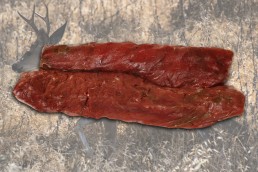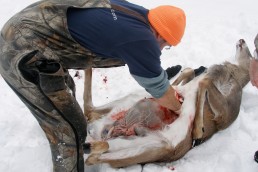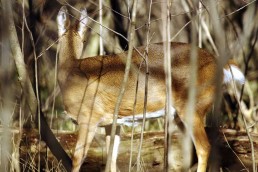The Filet Mignon of Venison
SHARE THIS POST
Grilled Venison Backstrap
We’ve moved into the warmer months now, and it’s time to clean the grill.
Let’s start out by thawing some of that venison you’ve stashed in the freezer. Grab a chunk of backstrap. Venison backstrap is the loin consisting of muscles on each side of a deer’s spine. It’s considered the “filet mignon” cut because the muscle is not weight-bearing, like the shoulder, and it contains less connective tissue, which makes it very tender.
Let me qualify that statement.
Filet mignon (French for “cute fillet”) is a steak cut, whether from a cow, deer or squirrel (if you want to go to the trouble of separating it). It’s taken from the smaller end of the tenderloin of the critter. Backstrap is the whole tenderloin. It runs the length of the deer along both sides of the backbone and is usually harvested as two long cuts. Beef and pork tenderloin is what you can buy at a grocery store and can be bought whole or in different cuts.
The loin, when sliced across the short dimension roughly creates a round cut. These cuts are called fillets (notice the different spelling of fillets?), but if they come from the small forward end of the backstrap they are considered to be filet mignon. Some butchers in the U.S., however, label all types of tenderloin steaks “filet mignon.”
The shape of the true filet mignon can be a hindrance when cooking, so most restaurants sell steaks from the wider end of the tenderloin (not the “mignon”) because it is both cheaper and much more presentable. The tenderloin is the tenderest cut of beef, deer or squirrel and is also arguably the most desirable and the most expensive. When you order filet mignon, make sure of what you’re getting.
These cuts are usually not as flavorful as some other cuts of beef/deer/etc. (prime rib, for instance), and is often wrapped in bacon to enhance flavor, and/or is served with a sauce.
Cuts in front of the hips of a cow are, from top to bottom, sirloin, tenderloin, top sirloin and bottom sirloin. It’s about the same on a deer except the cuts are much smaller.
I take it for granted that when you butcher your deer, you whack out the long tenderloins and set those aside before the carcass goes to a butcher. Well, that’s my modus operandi; you may butcher the whole deer yourself. I keep those long loins at home, destined for my grill. Hence, our recipe this month.
Are you enjoying this post?
You can be among the first to get the latest info on where to go, what to use and how to use it!
Grilled Venison Backstrap
4 two-inch-thick venison backstrap steaks
Marinade
Olive oil (about 3 tablespoons for every 2 pounds of venison)
Salt to taste
Pepper to taste
Seasonings, optional (onion powder, garlic salt)
Fresh herbs, optional (rosemary, thyme, oregano)
Mix oil and seasonings. Fully coat steaks in shallow dish and set in refrigerator for at least 2 hours or overnight. Turn the steaks at least once. The longer the steaks marinate, the more robust the resulting flavors from the seasonings will be. Preheat your grill to high. If you like grill marks, rotate steaks 90 degrees after 2 to 3 minutes. Cook the steaks for about 5 to 6 minutes on each side for medium-rare doneness. Remove steaks and rest a few minutes before serving. Serve steaks with grilled herbed potatoes and a fresh green salad.
MWO
SHARE THIS POST
Did you enjoy this post?
You can be among the first to get the latest info on where to go, what to use and how to use it!
Vernon Summerlin
For more than 30 years, Vernon Summerlin has produced outdoor articles and books that can be found on Amazon; most recently How to Analyze a Bass Hole: Think and Catch’em! He is the recipient of more than 40 awards for magazine and newspaper articles, TV, radio, photography and books.




back straps comes off the top on either side of the backbone, tenderloin comes from the inside of the animal below the spine toward the back of the animal. both are tender but. they are diffrent pieces of meat.
thank God someone knows what they are talking about – there is an abundance of advice given by pseudo experts
[…] an air fryer, cook the venison filet mignon for 5-7 minutes or until it reaches a medium-rare internal temperature of 135 degrees F, then […]
[…] that backstrap and tenderloin are the same. According to an article that was published in Midwest Outdoors, filet mignon is taken from the tenderloin, which is a […]